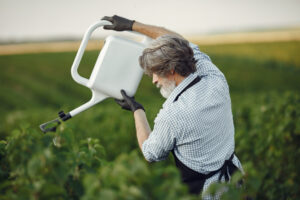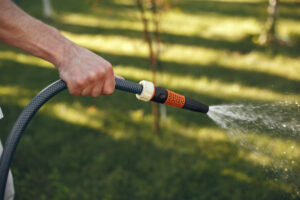 For many, watering the lawn is an art, even more so if we want to save Water and preserve our beautiful plants. But the work is made very simple, taking into account the following recommendations:
For many, watering the lawn is an art, even more so if we want to save Water and preserve our beautiful plants. But the work is made very simple, taking into account the following recommendations:
- Install an irrigation system that includes the use of programmers and solenoid valves. This will allow only what is necessary to be watered.
- Water in the morning, which is the time when the least Water is lost through evapotranspiration.
- The materials we use for our irrigation system must be of excellent quality. This allows us to avoid leaks that cause water waste or poor water distribution due to clogged or sunken nozzles.
- Doing deep and spaced watering will allow better root development. This is because the roots will grow deeper by allowing a little stress. Likewise, making it deeper will allow all of the roots to be covered.
Having a healthy, green lawn without wasting Water is important. Thanks to these five techniques to save Water when watering the lawn, we will make it possible to help the planet. We have tools, supplies, seeds, fertilizers, and materials to help you in this wonderful work.
Integrated (Or Buried) Watering.
This watering system is certainly the most discreet but also the most difficult to implement. Burying the pipes requires digging trenches, which, once inplace, prohibit any movement or new planting in the areas concerned. The sprinklers emerge from the ground under pressure and water your lawn or plants, only to disappear once the cycle is finished. Adding pumps is necessary in the event of insufficient pressure, and any anomaly in the circuit requires impractical handling. This watering system represents a higher cost than the previous ones and is justified in the case of large areas.
Maintenance And Wintering Of Automatic Watering Systems
In winter, your plants no longer require assisted watering. Natural rainfall is sufficient for their needs. Your sprinkler system needs to be cleaned and removed so it doesn’t get damaged or break from freezing. Here’s what to do before the cold weather sets in:
- Drain your circuit. Cut off the water supply at the base and open the purge or shut-off valves at the end of the network to evacuate the Water in the pipes.
- Remove the drippers or sprinklers and soak them inequal parts lukewarm Water and vinegar to clean them of the limescale accumulated during the season. Then rinse them with clean Water.
- Unscrew the programmer, empty it of Water, and remove the batteries.
- Roll up the pipeswithout bending them.
- Storeyour equipment in a frost-free location.
Appropriate Watering Frequency
The most convenient irrigation frequency depends on several factors, particularly the area’s characteristics and the time of year. The higher the heat and lower humidity in the environment, the more Water will be needed. In general, the frequency of grass spraying should be reduced in dry and very hot regions and more humid climates. In summer, it is recommended to do so every day; in spring and autumn, it is best to do so every other day; and in winter, twice a week.
 In any case, it is advisable to maintain low irrigation levels. If the grass receives a lot of Water, it “gets used to it” and suffers much more from any slight lack of moisture. Additionally, if it is not watered as much, the grass develops deeper roots to search for Water and nutrients in the substrate (within the shallow depth that the grass fits), providing it with greater defenses.
In any case, it is advisable to maintain low irrigation levels. If the grass receives a lot of Water, it “gets used to it” and suffers much more from any slight lack of moisture. Additionally, if it is not watered as much, the grass develops deeper roots to search for Water and nutrients in the substrate (within the shallow depth that the grass fits), providing it with greater defenses.
At somewhat lower irrigation levels, the appearance of the grass will suffer a little, but the difference will be minimal. On the other hand, the savings in water consumption can be very substantial, both at an environmental level and in the bill for the water supply.
Irrigation Management Is Used To Save Water When Watering The Lawn.
Irrigation system programming based on evapotranspiration (ET) losses. This avoids excess irrigation (loss due to leaching) or defect (less root depth)
You can save up to 20% of Water since replacing 80% of the evapotranspirated Water is enough to keep a lawn in perfect condition. There are irrigation control systems based on ET.…
